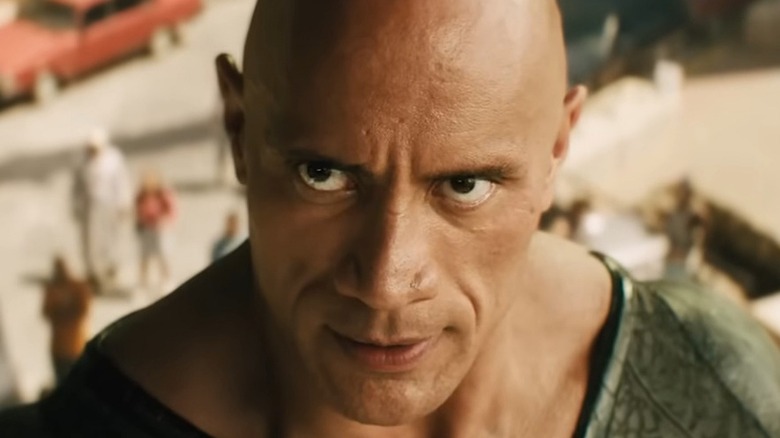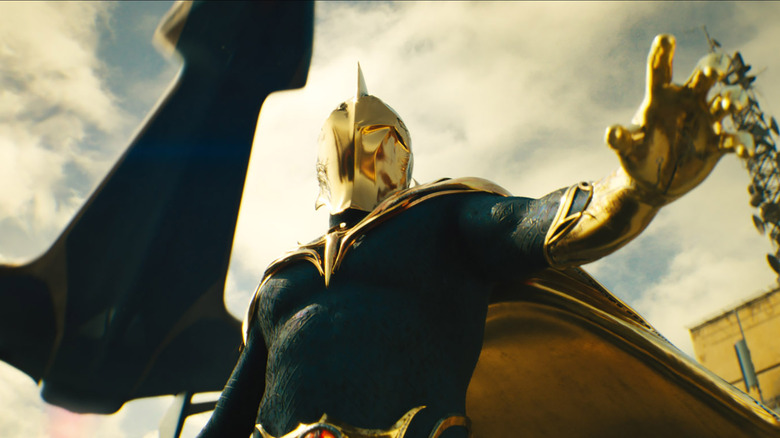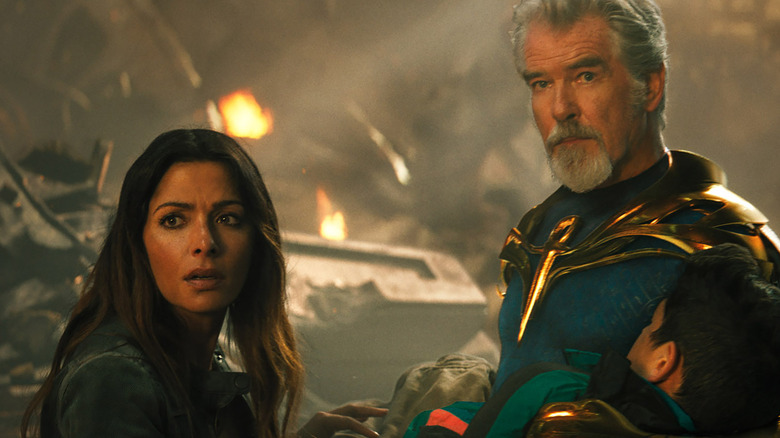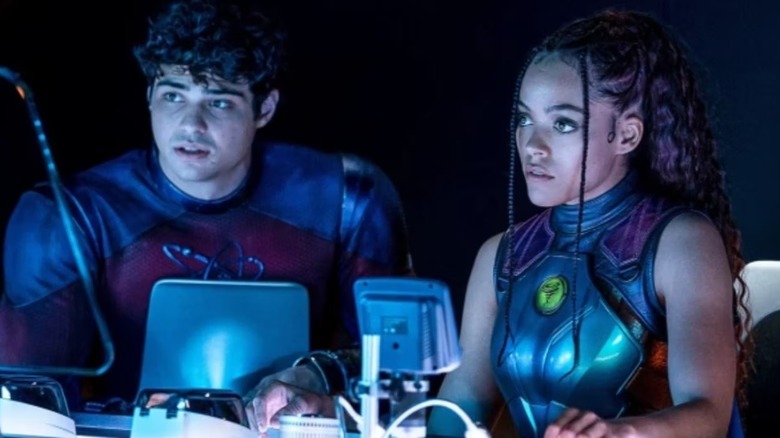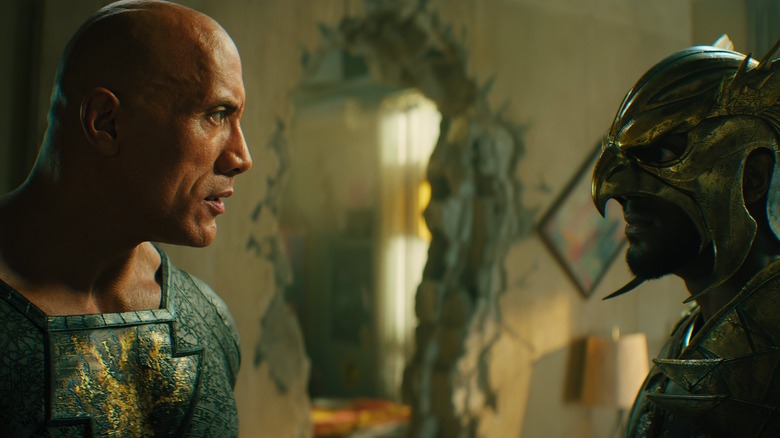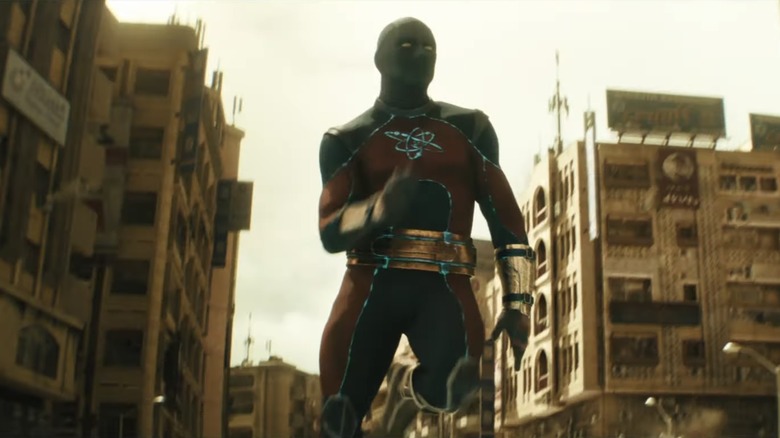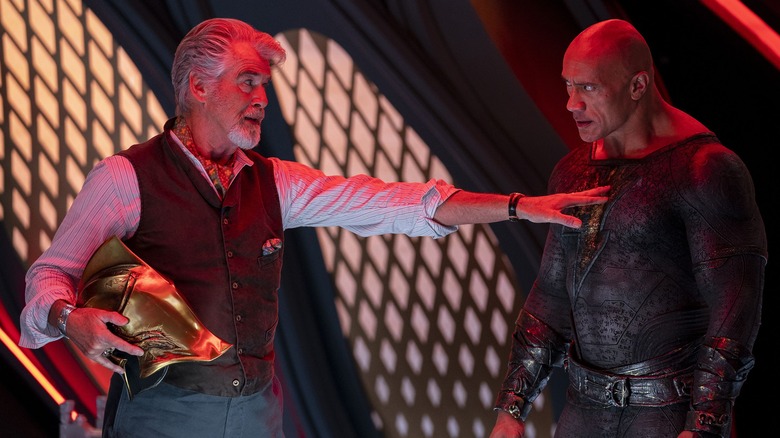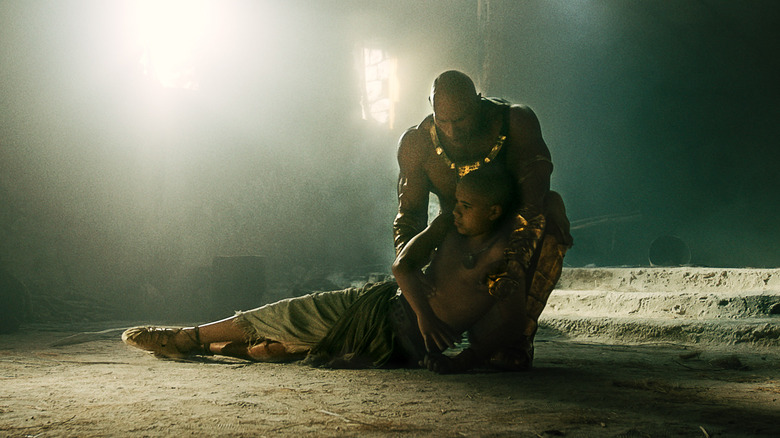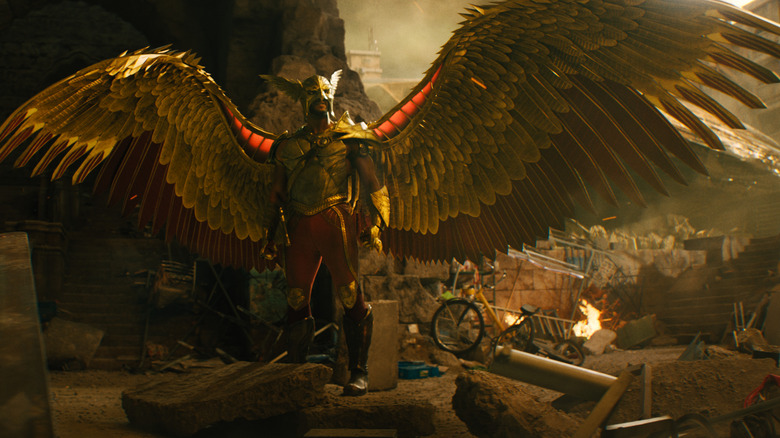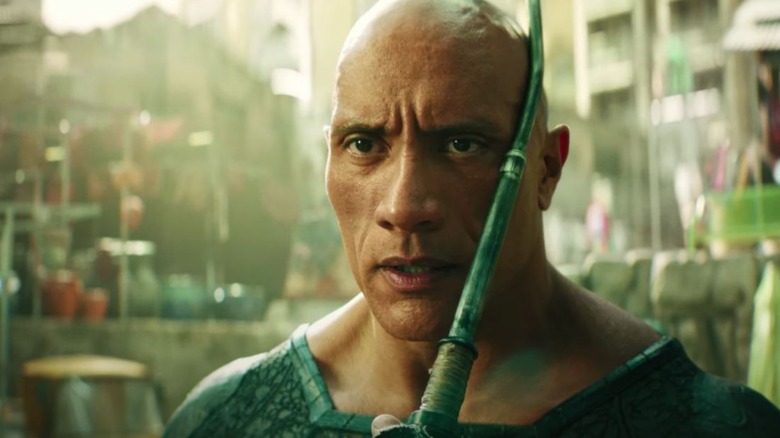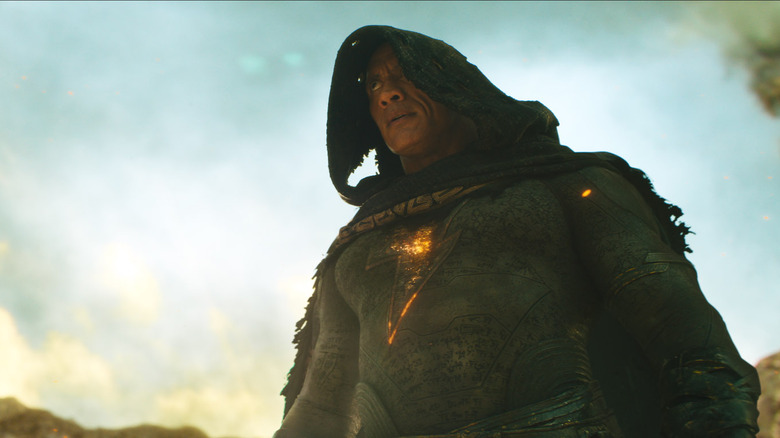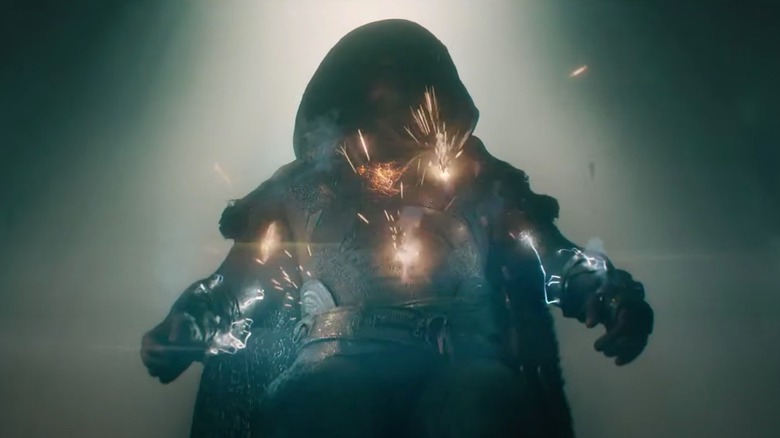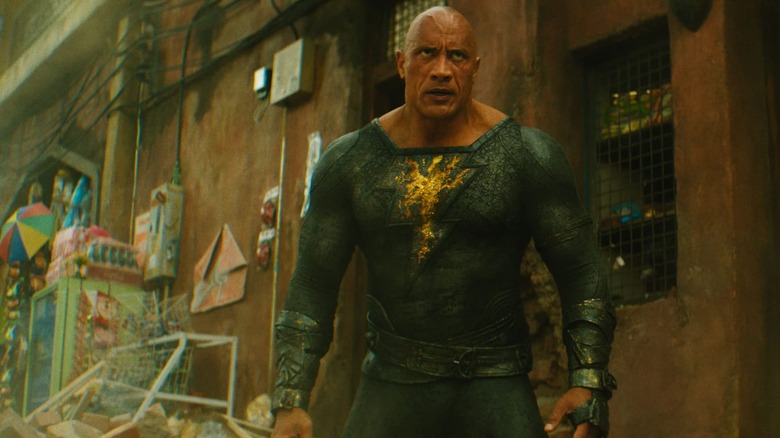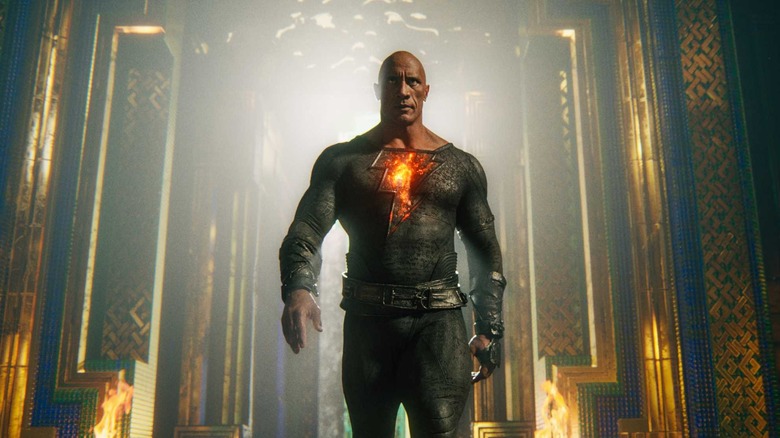The 7 Best And 7 Worst Things In Black Adam
Contains spoilers for "Black Adam."
"Black Adam," the eleventh entry in the DC Extended Universe, introduces the titular anti-hero (portrayed by Dwayne Johnson) into a superhero movie landscape dominated by do-gooders and kindly souls. Black Adam, on the other hand, is someone more prone to vaporizing evildoers or ripping off their heads instead of rehabilitating them. At its core, "Black Adam" wants to do something new with the template of a conventional superhero blockbuster. By and large, the film can't quite accomplish that, but it does have its share of entertaining sequences. Thanks to a fast-moving plot and a barrage of superpowered characters (the likes of Hawkman and Doctor Fate also factor into the story), there's usually enough happening on-screen to keep one's attention, even if little of it registers as something extremely memorable.
Breaking down the very best and very worst aspects of "Black Adam" makes the strengths and weaknesses of Johnson's inaugural DCEU entry incredibly apparent. While the presence of supporting players like Doctor Fate and the embrace of comic book silliness inform the movie's highs, its lows are dragged down by elements like a forgettable villain and equally disposable action sequences. "Black Adam" wants to be an idiosyncratic creature in the world of superhero cinema, but both its best and worst aspects will be very familiar to anyone well versed in 21st-century comic book adaptations.
Best: Pierce Brosnan as Doctor Fate
Former James Bond actor Pierce Brosnan enters the world of superhero movies with his turn as Doctor Fate in "Black Adam." On the page, it's a role laden with expository dialogue and plenty of opportunities to hand things over to a CG stunt double. Other actors might've understandably phoned this role in, but not Brosnan. He brings a world weary, but still hopeful, demeanor to his interpretation of this superhero, making a great contrast to the younger Justice Society of America members and the pessimistic Black Adam. Even better, Brosnan does have multiple opportunities to inject palpable gravitas into his turn as Doctor Fate. A third act scene in which the character recalls the first time he saw an airplane as a child is an especially good example of Brosnan bringing grounded humanity to an over-the-top character.
It's also delightful that Brosnan gets to deliver some memorable pieces of comic dialogue throughout "Black Adam," considering that his wit has only been sporadically utilized throughout his career. On top of all that, Brosnan's character gets the coolest-looking outfit of the entire movie, a comics-accurate depiction of Doctor Fate's colorful superhero garbs complete with a shiny golden helmet. Any way you look at it, Brosnan's Doctor Fate is the highlight of "Black Adam," with the only real downside of his performance being that he never gets a chance to sing "S.O.S."
Worst: The kid character
Director Jaume Collet-Serra has been very open about "Dirty Harry" being a point of inspiration for his vision of Black Adam (per Deadline). A scene in which "The Good, The Bad, and the Ugly" plays on a TV indicates that another morally flexible Clint Eastwood character, The Man With No Name, was also a source of inspiration for this incarnation of Black Adam. These aren't bad touchstones to aspire to when crafting a dark and violent protagonist, but the "Black Adam" screenplay bizarrely undercuts these gritty aspirations by saddling its titular character with a kid companion. Amon Tomaz (Bodhi Sabongui), the son of Adrianna Tomaz (Sarah Shahi), is obsessed with DC superheroes, as evidenced by all the decorations in his bedroom, so he's immediately enamored with Black Adam.
Pairing up a murderous action hero with a plucky young kid is a strange direction for "Black Adam" to go, especially since the kid gets trite self-referential dialogue about the world of superheroes (like Tomaz's comment about the "superhero industrial complex"). He never feels like a real child we can get invested in, and that makes his presence in the story a drag. Amon Tomaz is also a character who feels like he escaped from a '90s action movie, complete with a love for skateboarding, which further puts him at odds with the rest of "Black Adam." If you want to emulate Dirty Harry to The Man With No Name, leave plucky child sidekicks behind.
Best: Quintessa Swindell and Noah Centenio
Among the Justice Society of America members sent to deal with Black Adam are a pair of younger superheroes still getting a feel for the world of crime-fighting. This pair consists of Maxine Hunkel, aka Cyclone (Quintessa Swindell), who can produce supersonic winds; and Albert Rothstein, aka Atom Smasher (Noah Centineo), who can dramatically increase in size. They're a plucky duo always out to do the right thing, even though they're outmatched by the obstacles that emerge during the movie's epic conflict. Their determination to do good is quite endearing, and it's also welcome that the screenplay avoids playing the characters like caricatures of young people by jaded middle-aged studio executives. No tired jokes about "kids being on their phones" here.
Another advantage of Swindell and Centineo's presence in the movie is that they have really good chemistry together. This rapport ensures that their small scenes together, bonding over their shared inexperience in the world of superheroes, are more charming than you'd expect. It's unfortunate that the screenplay can't quite figure out more for Swindell and Centineo's characters to do, with the duo being especially superfluous during the climax. But at least whenever they're on screen, Swindell and Centineo prove engaging enough to make one curious about seeing them in further DC Extended Universe movies.
Worst: A dull CGI villain
The finale of "Black Adam" kicks off with the villain of the feature reaching his final form. After a visit to the underworld, Ishmael Gregor (Marwan Kenzari) transforms into the gigantic and powerful being Sabbac. A red organism resembling traditional depictions of Satan, Sabbac may be an intimidating foe to the superhero leads of "Black Adam." Unfortunately, he's not that interesting of a character for audiences to watch. Gregor's been hiding in the shadows for most of the movie up to this point and hasn't had a chance to leave an impression on viewers. His motivation for grabbing this supernatural power (concerning one of his ancestors being a dastardly king and his belief that the world was better when it was brutally ruled over by one being) is so hurriedly introduced that it has no impact on the plot.
Worse, once Gregor sizes up into a big red demon, he's just a CG creation that looks like it was rendered back in 2008. There's not much dramatic tension in watching the digital stunt doubles of Hawkman and Black Adam square off against a boss from an early PlayStation 3 game, even if Sabbac has thrown up a big red beam of light into the sky. Between the poor writing of Gregor and the subpar CGI used to render Sabbac, the ultimate villain of "Black Adam" is a total snooze.
Best: A colorful production aesthetic
In the vein of earlier DC Extended Universe outings like "Aquaman" and "Shazam!," "Black Adam" embraces bright colors and comics-accurate outfits in its production aesthetic. Part of why the feature remains as diverting as it does is because of its embrace of vivid primary colors. Swindell's Cyclone flies into battle followed by a rainbow-colored streak, while her default superhero outfit is dominated by a bright green hue. Doctor Fate's attire is covered in shiny visions of blue and gold, and the vivid golden color of Hawkman's armor is complimented by an equally radiant shade of red. Meanwhile, a flashback sequence involving wizards confronting Black Adam uses all the colors of a Crayola crayon box to demonstrate the combined might of these magical figures.
The various sets aren't quite as colorful as the superheroes who inhabit them, but certain backdrops, as in shots of Black Adam floating in chilly water that utilize noticeable streaks of blue, do maintain this visual quality. Not only does the abundance of vivid hues make "Black Adam" pleasing to look at, but there's also a welcome sense of confidence in how the movie approaches bright colors. The production shows an agreeable willingness to embrace the ludicrously stylized nature of the comics rather than subdue the hues of its source material to be seen as "realistic."
Worst: Awkward music cues
As "Black Adam" shifts its story from the distant past to the present, the soundtrack suddenly starts blaring the Smashing Pumpkins tune "Bullet with Butterfly Wings." The sudden presence of this song is incredibly amusing, and not just because it already played in the trailer for the 2018 Dwayne Johnson vehicle "Rampage." It just doesn't fit in with the rest of the aesthetic of "Black Adam" one bit, though it does establish a precedent for awkward needle drops that permeate the rest of the runtime. Black Adam's first rampage on modern human beings, for instance, is set to the Rolling Stones tune "Paint It, Black," which seems to have been selected solely because it features the word "black" in the title.
Even more baffling is the later use of the Kayne West tune "Power" for a sequence depicting Black Adam charging in to save a kidnapped Amon Tomaz. The song is used so briefly that it may as well have not even been utilized at all, while it's also a critical problem that "Power" has also been overused to death as a needle drop in the last decade of pop culture. The tunes in "Black Adam" are awkwardly incorporated into the feature and lack much in the way of personality. The brief bursts of music just seem to be chasing other superhero movies like "Deadpool" and "Guardians of the Galaxy" with their superior uses of pre-existing tunes.
Best: The willingness to be unabashedly silly
In the finale of "Black Adam," main villain Sabbac suddenly conjures up from the ground an army of skeletons that seemingly wandered in from "Jason and the Argonauts." There's been no mention of undead warriors up to this point, but suddenly, all the human characters have something to fight while Black Adam and the superpowered heroes battle Sabbac. It's inexplicable and more than a bit of a reach narratively, but it's certainly admirable how "Black Adam" keeps throwing ludicrous elements at the wall seemingly just to see what sticks.
Some comic book movies may balk at referencing weird lore from their source material. Thankfully, the affinity "Black Adam" shows for the preposterous means that the heightened origins of Doctor Fate remain intact while the plot can suddenly make a detour to the gates of the underworld without feeling like it came out of nowhere. Elements like the Intergang riding around on hover-bikes are just part of the tapestry of the movie and don't require prolonged explanations or a grounded interpretation to exist. Admittedly, the movie's approach to silliness can be exhausting in spots and overall isn't quite as cohesive as the even greater barrage of ludicrousness in the DCEU's "Aquaman." But nobody can say "Black Adam" doesn't give audiences a lot of tomfoolery-infused bang for their buck.
Worst: A clumsy narrative structure
The screenplay for "Black Adam," penned by Adam Sztykiel, Rory Haines, and Sohrab Noshirvani, initially follows the in-universe public perception of the mythical figure Black Adam. Specifically, it's believed that this super-powered being's alter-ego was Hurut (Jalon Christian), a brave adolescent warrior who defied the corrupt king Anh-Kot centuries ago. As the story goes on, the layers of the mysterious Black Adam are peeled back to reveal that he is, in fact, Teth-Adam, the father of Hurut. Though his child did initially have the powers of Shazam, the wizard then bestowed Teth-Adam with these mystical abilities. After doing so, a vulnerable Hurut was murdered, leaving Teth-Adam with so much violent rage that he had to be imprisoned for eons.
There's an interesting story in there about a dad feeling unworthy and how that manifests in his violent personality, but it emerges too late into the movie to mean anything. Up to this point, Black Adam has been a blank slate without any internal drama to make us care about his plight. Giving us this information about what fuels his behavior would've made everything so much more engaging. Even more baffling, anyone remotely familiar with Johnson's voice will see this twist coming a mile away. A prologue in "Black Adam" features Hurot's father, who is obscured from the viewer but talks in the recognizable vocals of The Rock. Every way you look at it, concealing the title character's past like this was a mistake and does nothing but needlessly convolute the plot of "Black Adam."
Best: Casual DC Extended Universe connections
"Black Adam" is firmly rooted in the foundation laid by the preceding movies that populate the DC Extended Universe, but anyone worried that this means that the film might awkwardly shoehorn in connections to other DC properties can rest easy. "Black Adam" does feature characters from other DCEU projects, but unlike the montage of security camera footage setting up Justice League superheroes in "Batman v Superman: Dawn of Justice," these cameos and pieces of connective tissue aren't intrusive. These include Djimon Hounsou reprising his role as the wizard Shazam from the 2019 movie "Shazam!" in a handful of flashback sequences, while Viola Davis' Amanda Waller reappears from the "Suicide Squad" movies as the figure giving the Justice Society of America their mission to take down Black Adam.
Speaking of "The Suicide Squad," Jennifer Holland reprises her character Emilia Harcourt from that film and "Peacemaker" in a brief appearance in "Black Adam." These characters function just fine in the narrative of "Black Adam" even if you've never seen them in another movie, while "Black Adam" wisely eschews any chances to stop its story dead in its tracks to set up future movies. The only truly pronounced DCEU connection is reserved for a standalone mid-credits scene. Overall, "Black Adam" does a fine job occupying and acknowledging a broader cinematic universe without derailing its own screenplay in the process.
Worst: The surface-level approach to foreign intervention
In a key moment in the middle of the movie, Adrianna Tomaz lays into Hawkman and the other members of the Justice Society for their immediate intense interest in Black Adam. Though these superheroes say they're pursuing this mystical being because he's a threat to Kahndaq, she notes that they've been very selective in what Kahndaq affairs they get involved in. Specifically, she notes that none of these superheroes stepped in during the 27 years Kahndaq has been taken over by foreign invaders like the criminal organization Intergang. This moment is supposed to provide commentary that, on paper, could draw parallels to how and when America chooses to act in terms of foreign policy.
Unfortunately, these potentially weighty ideas don't go anywhere in the story, beyond an early mention of "imperialism" from Amon, and Black Adam later saying "not your country, not your decision" when Hawkman wants to intervene in a risky plan enacted by Adrianna. Any references to Western intervention in foreign countries eventually get long-forgotten once a generic climax full of CGI villains gets underway. This brief insight into the frustrated mindset of Adrianna Tomaz seems to suggest "Black Adam" is about to go somewhere really heady and challenge the audience's conceptions of "a villain." Unfortunately, in the context of the whole film, it's a brief digression that ends up being a strange aberration in the narrative.
Best: Some of the early violence
When Black Adam is awakened from his tomb, the ancient anti-hero first sees a bunch of gun-wielding mercenaries holding an unarmed woman hostage. It only takes a few seconds for Black Adam to lay violent waste to these mercenaries. Being the first intimate display of his powers, the movie makes sure its title character dishes out some especially pronounced violence on his adversaries. A man's arm is ripped off on-screen, while another individual is reduced to a skeleton by Black Adam's electricity powers. All of this occurs before Black Adam exits the cave, at which point he encounters another massive army he promptly dispatches.
Anyone who has watched any R-rated action movie won't be disturbed or even especially impressed by the mayhem Black Adam dispatches. Still, outside of "The Suicide Squad," the DC Extended Universe hasn't been home to this kind of cartoonish violence. This lends some sense of specialness to Black Adam's initial rampage, especially the moments — like him plopping a grenade into a soldier's open mouth — that are infused with dark humor. With this memorable spree of carnage, both the superpowers and violent tendencies of Black Adam have been firmly established.
Worst: The weightless action sequences
It's always difficult for superhero movies involving incredibly super-powered individuals to figure out ways to make action sequences that don't just turn into a parade of artificial digital trickery. While superheroes skilled in hand-to-hand combat like Daredevil, Batman, or Shang-Chi can rely on tactile fight choreography to keep audiences engaged, superheroes who utilize the powers of flight or other abilities that can only be realized through visual effects tend to have a tougher time with staging weighty skirmishes. Unfortunately, "Black Adam" tends to suffer from this problem in its action-heavy sequences.
Between the enormous version of Atom Smasher being a CGI figure with fake-looking textures and a distracting digital double for Dwayne Johnson whenever he flies around, the sequences in "Black Adam" meant to wow fans will mostly just remind you that most of this was shot in front of a green screen. To compound this problem, the combat scenes are usually brought to life through choppy editing (most apparent in a brief skirmish between Hawkman and Black Adam in an apartment) and unimaginative fight choreography. It's not like the scenes of superpowered beings duking it out in "Black Adam" are a total waste, and they certainly come alive whenever Doctor Fate gets to do something cool. But too often they convey weightlessness that keeps audience engagement at bay and serves as a warning against relying too much on digital trickery in your fight scenes.
Best: Smartly utilizing Dwayne Johnson's physical presence
In one of the most memorable moments from the comedy "Trainwreck," a beefy character played by John Cena responds to being called "Mark Wahlberg" as an insult by saying that he's so muscular that he "looks like Mark Wahlberg ate Mark Wahlberg." Using this logic, Dwayne Johnson looks like he gobbled up John Cena and then had Dave Bautista for dessert. He's a big muscular man, a towering figure who doesn't look like he came from everyday reality. This physique ensures that Johnson can't play normal people in movies (just try imagining him slipping into the cast of a naturalistic feature from a director like Sean Baker or Kelly Reichardt). But it does mean he's at least qualified to lend an immediate sense of authority to an ancient superpowered being like Black Adam.
From the moment he awakens and unleashes violence on a gaggle of mercenaries, Johnson's innately imposing stature serves him very well as Black Adam. He can just be standing around and still command a presence that makes his strength palpable. Johnson's size also works nicely when members of the Justice Society of America show up. Those bulging pecs and enormous arms make him an instantly credible threat to even a massively powerful hero like Hawkman. The jury's still out on whether Black Adam was the ideal comic book character for Johnston to play, but this DC Comics antihero does make good use of his physicality.
Worst: The struggle to juggle so many tones
If there's one particular flaw that is especially troublesome throughout "Black Adam," it's the feature's erratic tone. At times, "Black Adam" is clearly striving to be a dark story with brutal violence and a protagonist whose morality is often questionable. Simultaneously, though, it also wants to deliver lots of light-hearted comic relief, like that kid sidekick, while there are also fantasy elements on the margins of the story that become more and more prominent as the runtime progresses. "Black Adam" is being pulled in a lot of different directions, which isn't a bad thing inherently. Countless genre movies blend the grounded and fantastical in an organic fashion.
Unfortunately, the movie's attempts to go in so many tonal directions make "Black Adam" much more awkward. Lighter comic moments intrude on intense plot points (like scenes directly following up the kidnapping of Amon Tomaz) while darker bursts of violence (such as an opening depiction of a slave being murdered) clash against slapstick depictions of superheroes crashing into buildings. It's hard to get much of a footing on what atmosphere "Black Adam" is going for, and its erratic tone never feels like it's speaking to a larger theme or reflecting passionate creativity from the artists who made it. It just comes off like a movie so desperate to please everyone that it offers up every vibe it can think of, but in the process never quite refines any of these tones to perfection.
